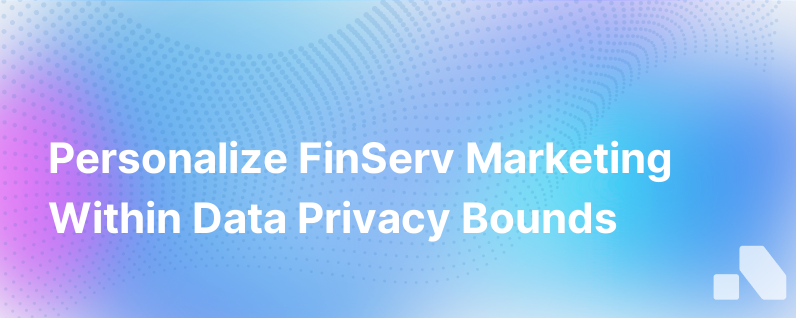
In the digitized expanse of financial services, the demand for personalization is reaching unprecedented heights. Customers no longer find solace in one-size-fits-all solutions; they crave tailored experiences that resonate with their unique financial journeys. However, personalization, particularly in the finserve industry, must deftly balance with strict data privacy regulations. As finserve marketers, it's pivotal to navigate this dichotomy—crafting marketing strategies that are both personalized and privacy-conscientious.
The Marketplace Demand for Personalization in Finserve
Consumers expect financial institutions to understand their needs and deliver products, services, and communications that cater specifically to them. A study by Epsilon indicated that 80% of consumers are more likely to purchase when brands offer personalized experiences. In the realm of financial services, the intimacy of the subject matter amplifies this need for personalization.
Personalized finserve marketing can lead to:
- Enhanced customer satisfaction
- Elevated conversion rates
- Increased brand loyalty
- A competitive edge in market segments
Yet, personalization comes with its intricacies and responsibilities, especially when you intersect with GDPR, CCPA, and other regulatory mandates that protect consumer data.
Understanding Data Privacy Regulations
Data privacy regulations like Europe's General Data Protection Regulation (GDPR) or the California Consumer Privacy Act (CCPA) impose stringent rules on how personal information is collected, processed, and secured. The guiding principle of these laws is to give individuals control over their personal data.
The repercussions for non-compliance are substantial, including hefty fines, legal actions, and reputational damage. Therefore, finserve marketers must ensure that precision in personalization also means precision in regulatory compliance.
Strategies for Personalized yet Compliant Finserve Marketing
Here's how you can approach personalization while keeping data prudence at the forefront:
Prioritize Explicit Consent
Transparency is paramount. Customers should be informed about what data is being collected and for what purpose. Ensure that explicit consent mechanisms are embedded into all your channels—be it online forms, mobile applications, or even over the phone. Customers are more likely to share their data when they understand the value exchange and feel in control.
Actionable Step: Implement a clear, user-friendly consent management platform (CMP) which logs all user consents and provides an easy way to withdraw them.
Leverage First-Party Data Tactically
First-party data is information directly collected from your audience. It’s deemed the gold standard for personalization due to its relevance and compliance with privacy standards—since consent has been granted.
Actionable Step: Develop rich segments of your audience based on transaction histories, account preferences, and interactions with your finserve products to tailor your marketing efforts.
Create Personalized Content with Context
Sometimes, personalization doesn't necessarily mean using a consumer's data. It can be about context—understanding where they might be in their financial journey and creating content that addresses those stages or events.
Actionable Step: Employ lifecycle marketing to offer relevant content that aligns with key milestones such as buying a home, planning for retirement, or beginning college.
Invest in Privacy-Friendly Technology
There are a number of technological solutions designed to deliver personalization while maintaining user anonymity, such as differential privacy and federated learning techniques.
Actionable Step: Explore privacy-friendly marketing platforms that enable data analysis without exposing individual identities.
Utilize Data Minimization Principles
Data minimization involves only collecting data that’s absolutely necessary for the task at hand and not holding onto it longer than needed.
Actionable Step: Regularly review the data you collect and retain. Strive to minimize it, keeping only what’s essential for providing the personalized services promised and ensuring compliance with data retention policies.
Foster a Culture of Data Privacy
Personalization should not fall solely under the jurisdiction of marketing; it’s also a privacy issue. Combining the perspectives of both departments can yield a more rounded and compliant approach.
Actional Step: Form cross-functional teams where marketing and data privacy leaders collaborate together on campaigns from brainstorming to execution.
Regularly Review and Update Compliance Measures
Data regulations are continuously evolving. A compliance practice that's relevant today might not suffice tomorrow. Always keep an eye on the legislative landscape.
Actionable Step: Conduct recurrent audits to test your marketing strategies and tools against the latest regulations, adjusting wherever necessary.
Educate Your Audience
Letting your customers know how their data is being used to improve their services helps build trust. It also reinforces their perception of control and understanding of the personalized value delivered.
Actionable Step: Create educational content around data privacy. Guide them through understanding their rights and how you protect their information.
Conclusion
The act of personalizing marketing while safeguarding privacy is undeniably nuanced in the finserve sector. It hinges on the synergy of customer-centric marketing, ethical data practices, and stringent adherence to privacy law. Navigating this intricacy efficiently is a testament to a financial service provider's commitment to both innovation and integrity, ultimately fostering trust, loyalty, and a formidable market standing.
In closing, as finserve marketers, we ought to harness the power of data-driven personalization responsibly, ensuring that we respect the privacy and preferences of our customers at every juncture. Our marketing efforts must reflect a balance between personal touch and personal space—delivering value without veering into violation of trust or regulatory mandates.
The responsibility is large, but so is the opportunity for differentiation and leadership in the increasingly customer-centric and privacy-conscious financial landscape.